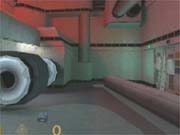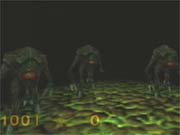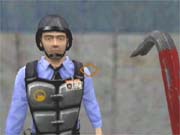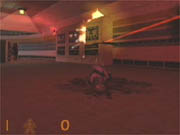Half-Life Preview
We receive a playable copy of the classic shooter's PS2 port.
Many regard Half-Life, Valve's 1998 first-person shooter, to be the genre's premier manifestation. The game debuted on the PC, and an ill-fated Dreamcast port was in the works until very recently. However, Gearbox--the studio that put together the involved DC port and handled the recently released Blue Shift expansion for the PC version-- also has a PS2 port in the works that, barring disaster, is 100-percent likely to see the light of day. In essence, the game is direct port of the PC version, albeit optimized for the PS2 hardware. The game will also incorporate the high-definition models found in the Blue Shift for the PC, which are significantly more detailed than the ones found in the original PC version. Finally, Gearbox has added an entirely new cooperative multiplayer scenario to the game, which adds a significant amount play time to the already robust game.

Half-Life is significant for a number of reasons, but foremost is its unique presentation of story. Calling the game "cinematic" is not only a gross understatement, but it also doesn't begin to touch on the subtle ways it weaves its story seamlessly into its play sequences. Rather than presenting players with a series of cutscenes aimed at furthering the game's narrative, Half-Life literally puts you in the shoes of Gordon Freeman, a low-level research scientist who must endure a nightmarish romp through a remote government science facility. Using the game's first-person perspective to marvelous effect, the game manages a rare level of immersion--in place of static cinematics, scripted events unfold before your eyes, forcing you to react in real time to conditions that both further the game's story and affect its gameplay. A good example of this is the game's intro sequence. While it is by no means exciting in the traditional sense, it nonetheless achieves quite successfully what in-game cinematics attempt, often with lesser effect--it introduces you to both the game's world and its central characters (in this case, Gordon and the various scientists and security guards inhabiting the Black Mesa compound). Throughout the sequence, you're confined to a tram traversing various areas of the facility while a digitized voice briefs you on the nature of the compound and the work conducted there. You retain full control of Gordon while in the tram, so you can walk up and down it and peer out its windows at an active world of scripted elements doing their things. Machinery shifts about, robots do robot work, and people buzz about the less hazardous areas of the compound. A good bit of foreshadowing occurs here as well, though only the truly observant will catch it--a definite hallmark of well conceived interactive storytelling.

Later sequences build on this in many ways. As the game has no concrete "levels," in the traditional sense, you'll often feel the actual transition between sequences more subtly. The actual partitions are more accurately described as scenarios in that they are presented as self-contained wholes, without the traditional score-compiling, mission-briefing bookends that we've come to associate with levels in first-person shooters. In a sense, the entire game feels like one long mission, and your sole objective is to survive, first the attacks of frightful aliens, and subsequently the assaults of government agents bent on cleaning up the transdimensional mess.
All the game's inventive narrative devices are thankfully present in the PS2 build of the game that we've been examining. While the port's integrity was never seriously in doubt, there was a tiny amount deep-seated dread that Gearbox would attempt to "consolize" the game, thereby robbing it of its untouchable, seamless flow. While we've yet to sample Decay--the game's exclusive co-op scenario--we somehow doubt that Gearbox has tampered with the formula seriously throughout its design. The current build of the game seems to be working decently well, despite its few kinks. In most cases, the game's performance is adequate, often running at a solid frame rate in the high 40s through the low 50s. During long, vacant expanses, it even reaches 60, while, during particularly heavy sequences, it'll drop as low as 15. We expect this to be a symptom of its early state, however, and one that will be cured well before its October ship date. There is sufficient time, in any case.

The game's character models, as mentioned before, are the aspects of it that have fared best in the port. They're all significantly more detailed, and they have a fuller overall look to them. Alien zombies, once muddled in the PC version, look much more vicious in this PS2 version, and the humans you encounter enjoy much more defined forms. What this amounts to, essentially, are higher poly counts and redrawn textures. Animations seem not to have changed much at all, however. The characters still move in the same slightly stilted manner as they did before. Monsters fare a bit better, as we have no other context to judge them by. The game's environmental textures, conversely, have taken the strongest hit. While many of them look quite sharp, others seem extremely low res, when compared with the game's other elements. Whether it's a consequence of the new hardware or a limitation present in the original version is unknown. What makes the spotty textures stand out is that they're scattered among crisp, high res ones that look like they may have been redrawn. In the end, we can only hope that all the game's textures receive equal amounts of love, for the sake of a cohesive visual production.

Our feeling is that this PS2 rev of Half-Life has the potential to be the game's definitive version. In short, nothing else will do--this is a port of a three-year-old game, and, given both the powerful hardware at the team's disposal and the wealth of resources available to those working with the Half-Life name, anything else would largely feel like a waste of time. For what it's worth, the game seems to be on the right track. It's already playing very well, and the visual blemishes are small, when considered in the grand scheme. The game will support a mouse and keyboard control scheme by means of the PS2's USB ports, so those craving an authentic experience should be well accounted for.
We're as eager as you are to see how Half-Life turns out on the PS2. The game is scheduled for a late October release, so stay with us for the next update. Till then, enjoy the media barrage.
Got a news tip or want to contact us directly? Email news@gamespot.com
Join the conversation